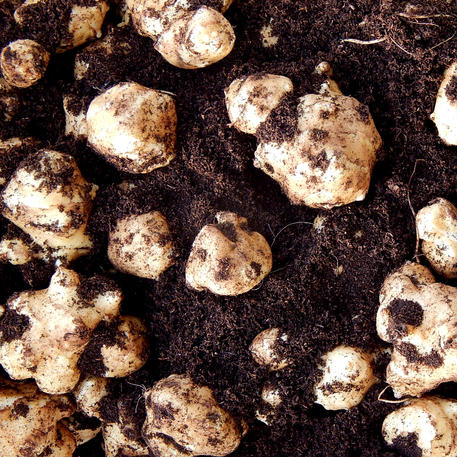Filter By OPTIONS
- 5 Tubers $6.95
-
Filter By Stock
- In Stock (0)
JERUSALEM ARTICHOKES
BOTANICAL NAME: Helianthus tuberosus
COMMON NAMES: Sunchoke, Earth Apple, Sunchoke, Sunroot, Wild Sunflower, Lambchoke, Canadian Truffle
FAMILY: Asteraceae, part of the daisy family
ORIGIN: Heirloom first cultivated by the Native Americans.
PLANT DESCRIPTION
A hardy, tall, herbaceous perennial that grows up to 3 m high with a yellow flower similar to a sunflower. It will grow in most soil types but prefers light, sandy soil of good fertility. It does best in temperate climates. In warmer, more humid areas it can still be very productive but is unlikely to persist in the ground from year to year. It will need to be replanted from stored tubers. Tubers store well in the crisper part of the fridge in a plastic bag. In warmer areas it can be grown successfully year round by regular replanting but is best planted at the beginning of the wet season.
USES
Jerusalem artichokes produce a large numbers of edible tubers. They are especially good for diabetics as they contain no starch, the carbohydrate is in the form of inulin and laevulin, which are readily metabolised as the natural sugar, laevulose. Tubers should be scrubbed not peeled and can be boiled or baked, when very fresh they can be grated raw in salads or pickled.
May also be planted as a useful windbreak for the vegetable garden. Also useful as an animal forage, the tops can be grazed down in autumn, before harvesting or as a fodder crop for pigs, allowing them to root up the tubers themselves.
PLANTING DETAILS
Propagation is by tubers, any small piece left in the soil after harvest will probably shoot, so plant it where you want it to grow, as it can be hard to eradicate (in cooler areas). The recommended planting time is spring. To plant, cut the tuber into sections with 2-3 buds. Cover the tubers with soil to a depth of 10 cm. Plant in rows 70 cm apart, 25 cm between plants in full sun, mulch well. Jerusalem artichoke needs a good supply of potassium, this can be supplied with wood ash, avoid high nitrogen fertilisers or the tops will grow at the expense of the roots.
Flower stems should be removed to allow nutrients and growing energy to go to the roots producing higher yields.
Tubers are best harvested 4 to 6 weeks after flowering. Tubers do not store well after harvest so are best used fresh or stored in a slightly damp sawdust or sand in a dark place; or in a plastic perforated bag in the bottom of the fridge.
COMPANION PLANTS
LIKES: Climbing Beans, Cucumbers, Corn, Peanut, Rhubarb, Echinacea, Lettuce, Spinach, Broccoli, Cauliflower

JERUSALEM ARTICHOKE (5 Tubers)
Heirloom first cultivated by the Native Americans. Also known as 'Earth Apple' or 'Sunchoke'. Perennial (warm areas) growing to 3m high, with attrac
$8.95
